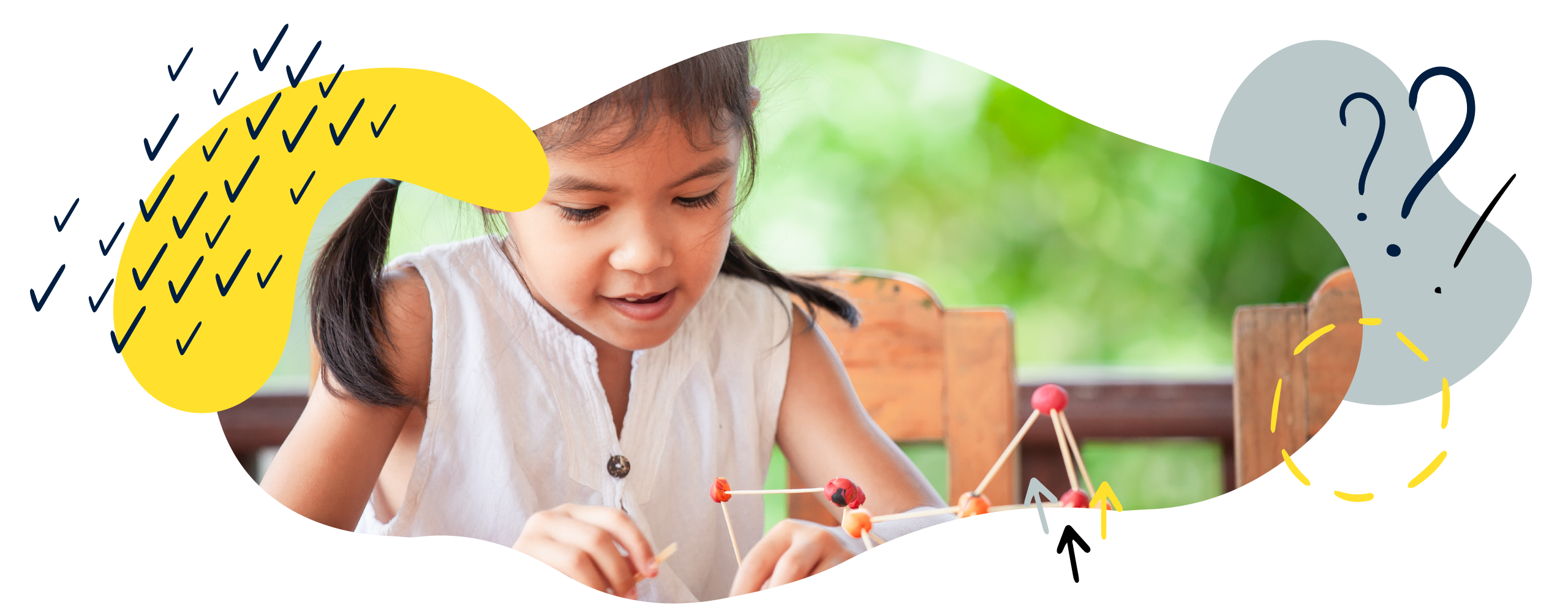Geometry & shapes
From investigating 2D and 3D shapes to exploring maps and angles, geometry is one of the most practical areas of learning that you can support at home.
Before we move into how you can support your child at home, our simple glossary of key words will give you a clear understanding of the vocabulary your child will be using at school.
Maths glossary
Use these quick links or explore our education glossary for simple definitions and examples of mathematical terms.
- 2D (or ‘two-dimensional’) shapes are flat shapes. They have length and width but no thickness.
- 3D (or ‘three-dimensional’) shapes are solid shapes. They have length, width, and height.
- Coordinates are two numbers or letters that describe a position on maps, graphs, and charts.
- A Polygon is any 2D shape with straight sides. Triangles, squares, and rectangles are types of polygon.
- Something is symmetrical if one half is exactly the same as the other half but the opposite way round.
How to help your child at home
You don’t need to be an expert to support your child with maths! Here are four simple but effective ways to help your child develop their understanding of geometry.
1. Speak ‘shape language’
Look for shapes in the world around you and help your child to use accurate mathematical language to describe them in terms of their properties. For example:
It has six faces.
It has twelve edges.
It has eight corners (or vertices).
It has right angles.
It has two lines of symmetry.
2. Make a treasure map
Help your child to draw a map of your house or garden on a coordinate grid. Take turns to hide ‘treasure’ around the house and give each other coordinates from the map as clues for the position of hidden objects. You can find a treasure map to help you here.
3. Play guessing games
Imagine a 2D or 3D shape. Can your child guess which shape you are thinking of by asking questions about its properties? Can they draw or make it from modelling dough just from your description? Can they identify shapes by touch alone?
4. What’s in the bag?
Using a simple plastic bag, place various 3D objects from around the house into the bag and take it in turns to describe them by their 3D properties. Perhaps you can award points if you or your child is able to describe the shape by using the correct vocabulary. You can use our maths glossary to help.
Want more?
To help your child’s learning further, you may want to watch some of the videos included within our dedicated maths library. If you’re looking for more ideas to support learning at home, head over to our maths blog to explore articles full of top tips and fun activities.
What your child will learn at school
For more information about your child’s learning in a particular year group, use this handy drop down menu:
Geometry in Year 1 (age 5–6)
In Year 1, children will be expected to be able to identify simple flat (2D) and solid (3D) shapes and use mathematical vocabulary to describe position, direction, and movement. This includes:
-
- recognising and naming common 2D shapes, such as circles, triangles, rectangles, and squares
- recognising and naming common 3D shapes, such as spheres, pyramids, cones, cuboids, and cubes
- describing whole, half, quarter, and three-quarter turns.
Geometry in Year 2 (age 6–7)
In Year 2, children will be expected to be able to compare and sort common 2D and 3D shapes and everyday objects and continue patterns of shapes. This includes:
-
- describing 2D shapes (including number of sides and lines of symmetry)
- describing 3D shapes (including number of faces, edges, and vertices)
- describing turns using clockwise, anti-clockwise, and right angles.
Geometry in Year 3 (age 7–8)
In Year 3, children will be expected to use accurate mathematical language to describe a wider range of symmetrical and non-symmetrical shapes. This includes:
-
- drawing 2D shapes and making 3D shapes
- identifying angles greater or less than a right angle
- identifying horizontal, vertical, parallel, and perpendicular lines.
Geometry in Year 4 (age 8–9)
In Year 4, children will be expected to expand their knowledge of the properties of shapes, and they will be able to describe the position of shapes on a coordinate grid. This includes:
-
- comparing shapes such as quadrilaterals and triangles based on their properties and sizes
- drawing mirror images of shapes in lines of symmetry
- plotting points and describing how shapes move up/down/left/right on a coordinate grid.
Geometry in Year 5 (age 9–10)
In Year 5, children will be expected to be able to solve problems about shapes by reasoning using their knowledge of geometric properties. This includes:
-
- drawing and measuring angles in degrees
- finding missing angles at a point, on a line, and in rectangles
- describing translations and reflections of shapes on a four-quadrant coordinate grid.
Geometry in Year 6 (age 10–11)
In Year 6, children will be expected to be able to construct shapes accurately and find unknown angles in triangles, quadrilaterals, and regular polygons. This includes:
-
- drawing 2D shapes from given dimensions and angles and building 3D shapes from nets
- illustrating and naming parts of a circle, such as radius, diameter, and circumference
- drawing, translating, and reflecting shapes in the axes of a coordinate grid.
